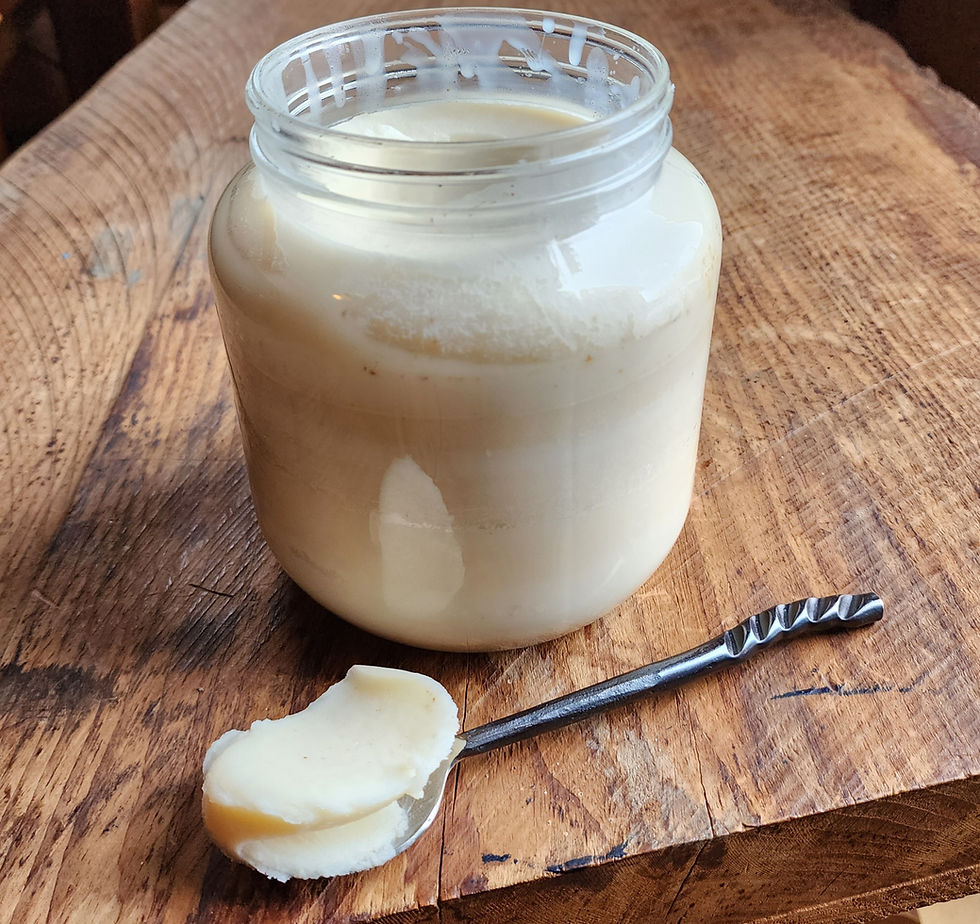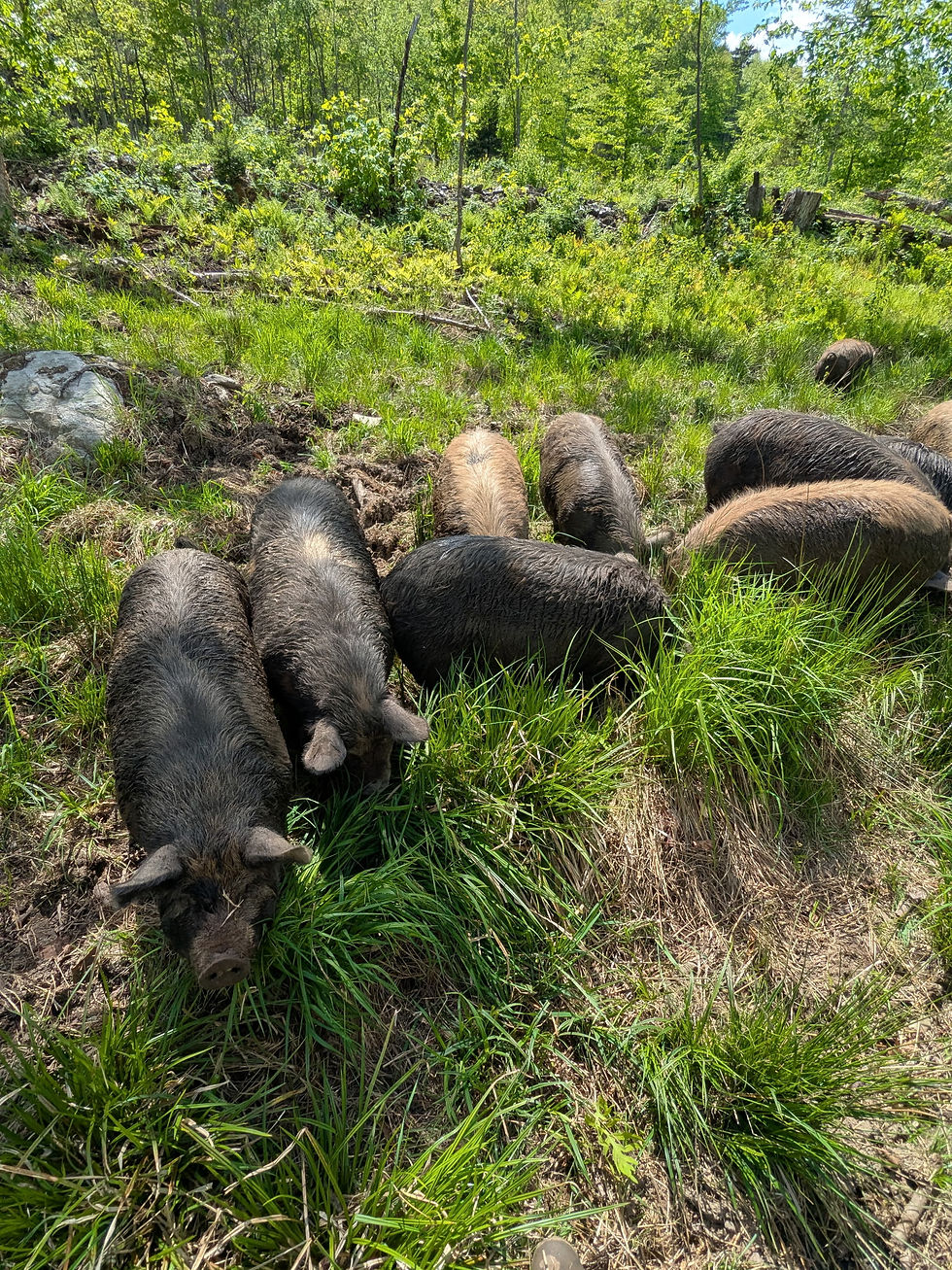Good Lard!
- Hilary Elmer
- Jul 18
- 5 min read
Were you brainwashed to think that lard is bad for you? That it makes you fat?
Think again.
Unprocessed lard made from pasture raised pigs is GOOD for you.
Better than many vegetable oils.

Not a Trans Fat
We should have been frying in lard (or tallow) all along.
If you visit the kitchen of a restaurant that has a deep fryer, chances are it will be filled with hydrogenated or partially hydrogenated vegetable oil. People used to think that vegetable oils were healthier than animal fats.
One of the many problems with vegetable/seed oils is that they turn rancid quickly, especially when heated. The industry found that altering the molecular structure of the fat, or turning it into a trans fat, solved this rancidity problem. The restaurant can use the same oil much longer.
Trans fats are hydrogenated oils. Generally hydrogenated oils were liquid at room temperature to start with, but are solid or semi solid after hydrogenation. Food manufacturers take hot seed oils and bubble hydrogen up through it. This causes a kink in the molecule, similar to saturated fats (which are solid at room temperature), but it is a different shape than any naturally produced fat chain.
This difference means that your body can't use it. Your body will try to use it, but because it's the wrong shape it doesn't function properly. It causes inflammation and lots of problems inside of you.
Naturally saturated fats are good because your body knows exactly what to do with it. You were designed to eat animal fat.
Just switching to any nonhydrogenated fat would solve those problems, right?
Well, yes, but... There is a way that people often unwittingly consume trans fats. If you cook with seed oils at high heat, guess what: it forms trans fats. Sigh. Seed oils really aren't good for you, especially in the context of frying.
Lard has a high smoking point of about 370F, which means that it doesn't form trans fats when used for frying. That makes lard one of the safest options for frying food.
Vitamin D
Vitamin D is a critical nutrient that your body needs to build and support healthy bones. Deficiency of it causes calcium loss which leads to soft bones.
According to the Cleveland Clinic, about 35% of American adults are vitamin D deficient.
You need sunshine to make your own vitamin D. We spend so much time inside, hidden from the sun, that many people can't make enough. Most people need to get it in their diet or through supplements.
Lard from pigs raised out in the sunshine is one of the HIGHEST sources of natural vitamin D. It has nearly as much as cod liver oil--and it tastes a lot better!
Winter time is an important season to make sure that you are taking Vitamin D through your diet. What little time you spend outside, your skin is mostly covered up, and the sun is low so you aren't getting strong rays of light. Cooking with lard or eating pasture raised pork (with the fat) is a great way to ensure that you are getting enough of this crucial nutrient through the dark winter.
Make sure that the lard is from pigs that were raised out on pasture, in the sun. Some small farmers raise pigs in confinement, so look for pasture raised pork.

Local
Buying local lard is a great way to reduce your carbon footprint. It has not been shipped all over the country or the world.
Your dollars stay local rather than going into the handy of greedy food corporations.
You are eating a whole, minimally processed food, not a product of the food industry that was exposed to so many chemicals that it is toxic.
Sometimes you can buy pork fat from the farmer and render it yourself, which is even cheaper than buying rendered lard.
What About Cholesterol?
Cholesterol is not bad. In fact, cholesterol is GOOD for you.
You need cholesterol to regenerate cells, absorb fat soluble vitamins, and produce hormones.
I'm not saying that having arteries clogged with cholesterol is a good thing. It's not. But eating cholesterol is not what clogs your arteries. Your arteries get clogged because of stress and inflammation. The cholesterol in your arteries is your body's response to try to heal it, like a band aid.
If you want to have low cholesterol, you need to stop exposing yourself to the things that cause inflammation, like cigarette smoke, sugar, refined carbohydrates, artificial sweeteners, seed oils, and alcohol.
I eat a LOT of lard and pork fat. I am healthy and thin and I have low blood pressure. If eating animal fat made you fat, I would be fat.

Not All Lard is Safe
Before you grab that package of lard on the grocery store shelf, wait!
That lard comes from pigs that were raised in a factory, which means that it will have traces of whatever chemicals those pigs consumed. It will not be high in vitamin D because those pigs spent their short lives inside.
And they HYDROGENATED it. Yes, really. Again, hydrogenated fats have a longer shelf life. And natural lard is fairly soft at room temperature, so hydrogenating makes it more firm, like crisco.
Even if you buy local lard, make sure that the farmer raises their pigs out on pasture and does not give them scraps from restaurants and food stores. Many farmers will do this to save money on feed bills, but that kind of food is just as bad for pigs as it is for people. Pigs fed on human industrial food scraps will have inflammation, and traces of the chemicals from that food will come through in the lard.
Buy lard from a farmer who pastures their pigs in plenty of grass, not on a tiny lot that has been reduced to dirt, and who feeds them only natural organic or non-GMO food.
How to Use Lard
You can use lard in just about any application you would use other oils in:
frying and sauteing
in breads and pastries
in soap
in skin care products
as a topping for bread or pasta
If you have ever had pie crust made with lard (rather than crisco, which is hydrogenated oil), you know how flakey and delicious it is. Nothing beats lard for pastry making. If you can find leaf lard, that is what you want for the flakiest pastries. Leaf lard comes from a different type of fat in the animal. It is a creamier white color and is firmer in texture.
Bacon Grease
When you cook bacon, or any cut of pork that had good marbling, there will be some fat that renders out. Save this and use it for cooking!

Would you be willing to try lard?
Buy my pasture raised lard, back fat, and other pork cuts at the farmer's market, here at the farm, or buy a half hog and pick it up directly from the butcher!






Comments